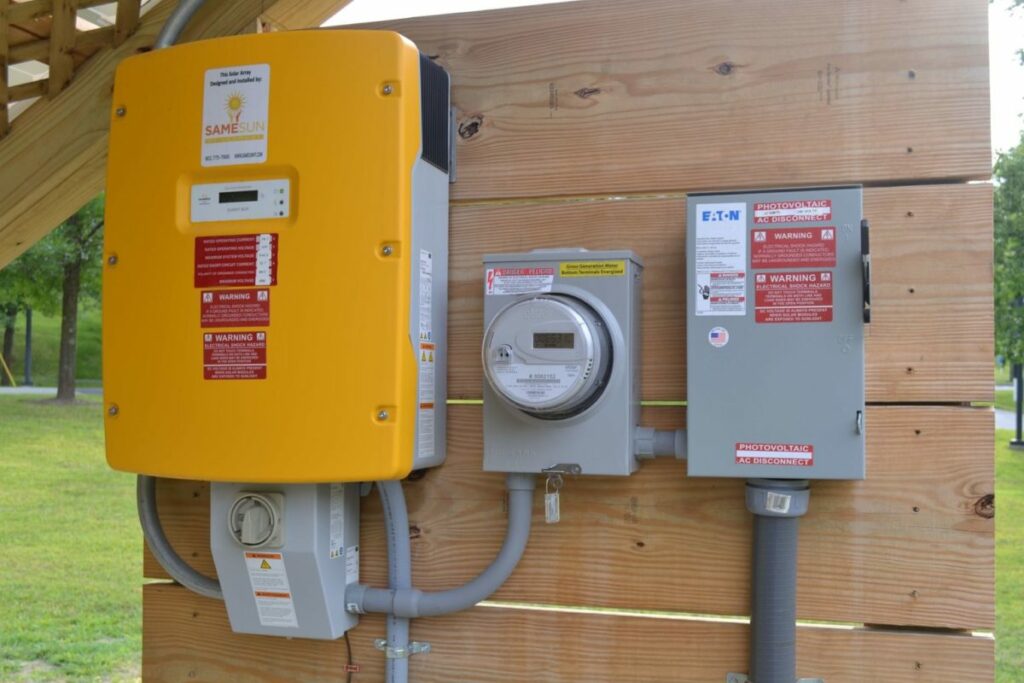Last update July 13th, 2024 at 05:40 pm
If you have a solar panel system or are planning to install one, you might have been told to overpower the solar inverter. This will mean that the inverter is undersized and that may raise questions.
Inverter overpowering means that you are installing a greater number of solar panels than what your inverter is originally rated for. This might seem to be a bad idea, as it is natural to think that your inverter and solar panels should match each other in terms of energy.
However, it might actually be a good idea to overpower a solar inverter.

First of all: What is a solar panel inverter?
The inverter is often considered the heart of a solar panel installation, as it is an important component that makes the system work. The inverter is transforming the direct current (DC) energy that your solar panels create, into alternating current (AC) energy.
Your home appliances need to be powered by AC energy, and because of this, the inverter is essential. Without the inverter, you will not be able to utilise the solar panel energy in any way.
What does it mean to overpower a solar inverter?
The number of solar panels (or the size of the solar array) needed, will depend on your household’s energy needs and the expected amount of sunlight. If you install a solar array that has a greater capacity than your inverter is rated for, this is called overpowering the solar inverter.
In other words, you have installed a greater number of solar panels than the solar inverter is supposed to handle. Based on the Clean Energy Council’s recommendations, the capacity of the panels should not exceed the inverter capacity by more than 33%.
Some examples
Imagine you have installed a 5 kW solar inverter. This basically means that your solar panel system will not be able to export more energy than 5 kW to the connected grid at any time.
It would make sense to combine the 5 kW solar inverter with a solar array size of 5 kW. And you could. But you could also set up a solar array that is bigger than 5 kW. If you install a solar panel system of 6.6 kW, this would mean that you are overpowering the solar inverter.
Here are some inverter sizes, and the maximum solar array size associated with each of them:
- Inverter size 3 kW: Solar array size 3.9 kW
- Inverter size 5 kW: Solar array size 6.6 kW
- Inverter size 8 kW: Solar array size 10.6 kW
- Inverter size 10 kW: Solar array size 13.3 kW
- Inverter size 15 kW: Solar array size 19.9 kW
Why should you oversize your PV array?
Installing a solar panel system that has a total capacity that is greater than your inverter capacity is often considered to be a good idea – although some power will go to waste.
If the size of your solar array matches the size of the inverter, this would mean that the energy produced by the panels rarely would be lost, because the panels produce more power than your inverter may use. But this is actually not a very big advantage.
Remember that the solar array rarely will be able to produce the amount of power that it is rated for. Because of this, you can add extra solar panels, and at the same time lose a minimum amount of power.
The extra capacity from your panels will actually help your inverter to work more efficiently. Most inverters can take 33% more energy than they are rated for. So instead of thinking that the solar array is “oversized”, it is actually “right-sized”.
By overpowering the inverter, it can yield more energy throughout the day. The inverter will spend less time working at low efficiency during poor sunlight. This will also compensate for the energy that is lost when the solar array has a bigger output than the inverter’s capacity.
How to calculate the right inverter capacity?
The regulatory authorities limit how much it is possible to overpower a solar inverter. The easiest way to calculate what size your solar panel array should be compared to the inverter is to multiply the solar inverter’s output capacity by 1.33.
This way, you will be able to find a solar panel system that exceeds the inverter capacity by 33%.
Find the right solar system and inverter for you
When you plan to install a solar array and an inverter, it might be beneficial to overpower the solar inverter. By doing this, you will be able to make your solar system work more efficiently.
Remember that you should not overpower your inverter too much. In general, the inverter can handle 33% more energy than what it is originally rated for. Your solar installer will help you to find the right solar panel system and inverter for your household.